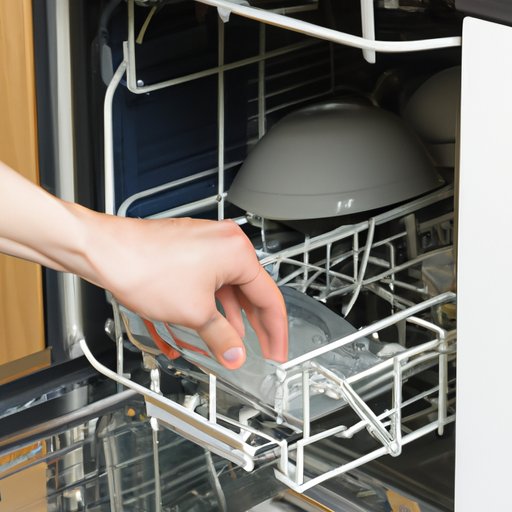
I. Introduction
If your dishwasher is broken, outdated, or no longer needed, it may be necessary to remove it from your kitchen, but it is important to do this safely and without causing any damage. In this comprehensive guide, we will walk you through the process of removing a dishwasher step by step, including tools you’ll need, common mistakes to avoid, recycling, and professional removal services.
II. A Step-by-Step Guide to Remove a Dishwasher
A. Turning off Power Supply
The first step in removing a dishwasher is always to turn off the power supply to avoid electrocution or fires. To do this, switch off the breaker or unplug the dishwasher from the wall.
B. Disconnecting the Water Supply
Once the power is off, locate the water supply line under the sink and turn off the water valve. Release the pressure by turning on the faucet, and then disconnect the water supply line from the dishwasher. Be sure to place a towel or bowl under the line to catch any water remaining in the valve.
C. Removing the Dishwasher from its Place
Now it’s time to remove the screws that hold the dishwasher in place. They typically attach to the countertop or the sides of the cabinet. For this task, use a screwdriver or a drill. Once the screws are removed, gently slide the dishwasher out about halfway.
D. Disconnecting the Drainage System
Next, locate the drainage pipe at the back of the dishwasher, and unscrew or loosen the clamp that holds it in place. After the drainpipe is disconnected, lift the dishwasher off of the brackets under the countertop.
E. Pull out the Dishwasher
With the dishwasher loose and free, you should now gently pull it out from under the countertop and away from the wall. Be sure to have a helper, so as not to damage the flooring while lifting out the dishwasher.
F. Cleaning the Space Post-removal
Once the dishwasher is out of the way, clean the space with a dry cloth or a vacuum cleaner. Check for any damage; if there are any scratches or dents, consider patching or sanding them.
III. Common Mistakes to Avoid While Removing a Dishwasher
A. Forgetting to Turn off Supplies
One of the most common mistakes people make is forgetting to disconnect the power and water supply before removing the dishwasher. This could lead to electrocution or water damage.
B. Lack of Organization
Another mistake is not being organized when you take the dishwasher apart. Keeping the screws organized is important, so you don’t have to struggle with replacing all the parts correctly.
C. Improper Lifting Techniques
Improper lifting techniques can put you and your helper at risk of back strain and injury. Be sure to lift from your knees and not from your back, or use a dolly to move the dishwasher.
D. Risks of Scratching or Damaging the Flooring
One last mistake is scratching or damaging the flooring while moving the dishwasher. Protect your floors by using a drop cloth and slide the dishwasher on it while moving it out.
IV. Tools You’ll Need for Successful Dishwasher Removal
A. Wrenches and Pliers
For the water line and drainpipe connectors, you’ll need pliers and wrenches to remove these parts from the dishwasher.
B. Screwdrivers
You’ll require screwdrivers to remove the screws that fasten the dishwasher in place securely.
C. Adjustable Wrench
An adjustable wrench will help you in a situation when you need to loosen tight nuts or fix the pipe thread.
D. Utility Knife
A utility knife will help you in cutting the silicon sealer that ensures the dishwasher is airtight and waterproof around the countertop.
V. Recycling Your Old Dishwasher
A. Preparing for Dishwasher Recycling
You can recycle your old dishwasher, which is very eco-friendly. However, for preparation of removal for recycling, remove any dishes and clean the interior of the dishwasher completely.
B. Disposing of Hazardous Materials in a Sustainable Way
Old dishwashers contain many hazardous materials, namely mercury switches, which can be harmful when not disposed of correctly. Recycle centers are equipped to handle these materials safely.
C. Identifying and Reusing Salvageable Components
Several dishwasher components can be recycled, including wires, motors, and copper piping. You can disassemble these components, and recycle them. Not only does this reduce wastage, but it also allows you to recover valuable resources.
D. Donating Your Old Dishwasher to Charities
If your dishwasher is in good working condition, you can donate it to a charity organization to help someone in need.
VI. Hiring a Professional Dishwasher Remover
A. Benefits of Hiring a Professional
If you feel unsure about removing your dishwasher, or you don’t have the necessary tools, hiring a professional is the best choice for you. A professional service ensures that the dishwasher is removed safely and disposed of sustainably.
B. Finding a Reputable Appliance Removal Service in Your Area
You can find a reputable appliance removal service by checking the reviews online or by asking for recommendations from friends and family. Once you find a reliable service, call them to discuss the removal and recycling of your dishwasher.
C. Comparison with DIY methods
If you are considering a DIY method against a professional service, you should know that a professional service has experience and tools necessary to ensure proper removal and disposal of hazardous materials.
VII. Conclusion
A. Recap of Key Points
Removing a dishwasher safely requires disconnecting supplies, removing parts in an organized manner, and using proper lifting techniques. Make sure to use appropriate tools to ensure a proper and safe dishwasher removal process.
B. Encouragement to Remove the Dishwasher Safely
Removing a dishwasher is not a difficult task, but it is necessary to approach it with care and attention to avoid damaging your appliance and the environment.
C. Call to Action
Whether you complete the dishwasher removal yourself or hire a professional service, be responsible and recycle your old dishwasher sustainably.




